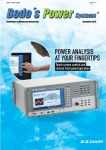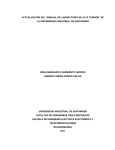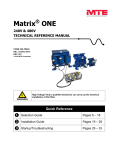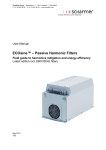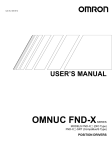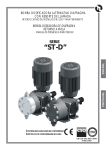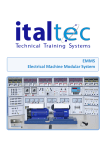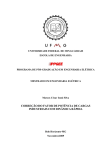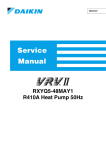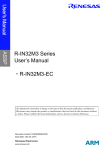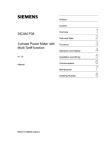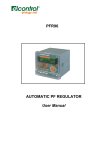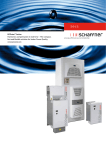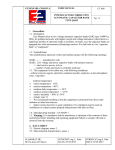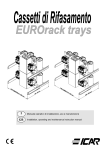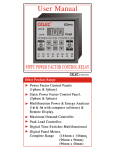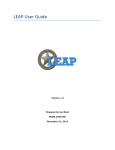Download Power Quality Solutions
Transcript
Power Quality Solutions Your essential guide to improving your power quality POWER QUALITY NHP Electrical Engineering Products Pty Ltd AUS NZ 1300 NHP NHP 0800 NHP NHP nhp.com.au nhp-nz.com WE’RE EASY TO DO BUSINESS WITH At NHP we’re solely committed to serving the needs of our customers in the industrial electrical industry. From concept design through to installation and after sales service, we are confident we have the experience and expertise to exceed your expectations and ensure you get the best result for your project. How? By combining Partnerships, Agility, Knowledge and Scalability, NHP can offer 100% Australian owned service that forms the ultimate choice in our industry. PARTNERSHIPS: AGILITY: When you choose NHP you gain a valuable industry partner. You gain access to an exclusive network of quality global suppliers who, together with NHP, can achieve an engineered solution for your industrial electrical application. A partnership with NHP promises to last, working together with you to offer complete trust, assurance and peace of mind. At NHP we understand your project needs and know that these needs can often change throughout the life cycle of a project. With a seamless combination of local and technical support backed by around the clock service and local stock, NHP has the agility to provide real time solutions where and when you need them. KNOWLEDGE: 2 SCALABILITY: If your industrial electrical application demands a specialist team of trained project management, design and engineering professionals, then NHP is the ultimate choice, bringing together over 40 years of electrical industry experience and knowledge. With all the scale of a large multi-national company, NHP maintain a premium level of customer service and attention to detail no matter how big or small your project. With over 900+ expert staff in over 50+ branch and regional locations, when you deal with NHP you receive all of this combined knowledge and expertise delivered by local people with with a local focus, backed by global suppliers. NHP ELECTRICAL ENGINEERING PRODUCTS PTY LTD Sales 1300 NHP NHP | nhp.com.au | Contents PFCP – Premier, fully modular PFC Solution 4 PFCP Order form 5 PFCE – Economical PFC Solution 6 PFCE Ordering Information 7 PFCW - Wall-mount PFC Solution 8 NHP PFCP functional trays 9 Electronicon LV Capacitors 10 Electronicon MV Capacitors 11 Mangoldt Reactors 12 Beluk Power Factor Regulators 13 Ghisalba Capacitor Switching Contactors 14 ECOsine Active Harmonic Filters 15 ECOsine Passive Harmonic Filters 20 Sine wave filter – FN5040 Series 23 Line Reactor 26 Output Reactor 27 Fuses28 Service29 CT’S – For PFC and AHF 30 MCCB selection guide for power factor capacitor application 32 Appendix: Additional information Power Factor Correction 33 Harmonics35 Output solutions for motor drives 37 Other useful documents Schaffner EMV AG Nordstrasse 11 4542 Luterbach Switzerland T +41 32 681 66 26 F +41 32 681 66 30 www.schaffner.com Schaffner EMV AG T +41 32 681 66 26 I I Nordstrasse 11 F +41 32 681 66 30 I I 4542 Luterbach, Switzerland www.schaffner.com energy efficiency and reliability ECOsine™ Harmonic Filters Operating and Installation Instructions (rev.4) Power factor correction system Firmware V02.08.xx Installation, maintenance and commissioning manual. October 2013 User Manual power QUALITY ECOsine™ – Passive Harmonic Filters Field guide to harmonics mitigation and energy efficiency Latest edition incl. 690V/50Hz filters NHP Electrical Engineering Products Pty Ltd Sales 1300 NHP NHP nhp.com.au January 2011 1/51 For more information, scan to download the NHP Catalogues App offering exclusive video content, catalogues and literature! 3 PFCP – Premier, Fully Modular PFC Solution The PFCP power factor correction system is the premier solution in the PFC family. Offering a fully modular CUBIC design, many different system configurations are possible. Design decisions include: top or bottom cable entry; load-break switch, MCCB or direct connect incomer; standard or advanced controller (with communications); and your choice of colour (RAL 7035 grey standard). The use of functional trays facilitates selectable correction granularity and makes system servicing a breeze. Standard Features • Modular design minimises installation time and costs • Detuning reactors fitted as standard • IP42 Protection • Top and Bottom Entry Options • Choice of incomer: direct connect, load break switch or circuit breaker • Integral ventilation system • RAL 7035 grey • Fully assembled, wired and tested, ready to install and connect Optional Features • Communication interface: Modbus over RS485 • Audible warning on fault • Contact to signal fault • Height: Shorter heights available on request • Colour: RAL 2000 Orange or alternative colours available on request System Sizes kVAr Range Incomer Type Available Steps Up to 300 Load-break and direct connect 1 6 Up to 250 Circuit breaker 1 5 Up to 500 Load-break and direct connect 2 10 Up to 450 Circuit breaker 2 9 Up to 800 Load-break and direct connect 3 16 Up to 750 Circuit breaker 3 15 600 mm 1200 mm 2340 mm Triple tier 2208 mm 2208 mm Double tier 2300 mm Single tier 4 No. of Tiers 2340 mm Please scan the QR code to view the fundamentals of Power Factor video 1800 mm Power Factor Correction - Premier Order Form Power Factor Correction - Premier Order Form Date: Customer Account Number: Customer Company Name: Contact Name: Email: Phone: NHP Rep / App Engineer: Project Name: To manufacture a PFCP system the following minimum information is required. 1. Total kVAr requirement: 4. Controller: Basic (BLR-CX): 2. Step Configuration: Advanced (BLR-CM): Number of 50 kVAr steps: Number of 25 kVAr steps: 5. Cable Entry: Number of 12.5 kVAr steps: Top Number of 6.25 kVAr steps: Bottom 3. Colour (please tick one option): Grey (RAL 7035) Orange (RAL2000) Other (please specify): 6. Incomer Type: Direct connect: Load break switch: Circuit breaker: Note: Other colours may incur additional cost and lead time Scan QR code to download order form Any other comments / additional requirements? Submit to NHP Sales Submit 6 5 PFCE – Economical PFC Solution 1300 mm With economy high on the design criteria, the PFCE delivers a highly economical, standardised PFC system in a compact footprint. Utilising the same high quality components as the PFCP, the PFCE delivers reactive compensation whilst maintaining vital airflow to ensure extended capacitor life. Standard features • Quality steel enclosure 2000 mm • Detuning reactors fitted as standard • IP32 protection • Top entry only • Integral ventilation system • Direct connect cable entry • RAL 7035 grey • Fully assembled, wired and tested, ready to install and connect Optional features • Load break switch • Communication interface: Modbus over RS485 • Audible warning on fault • Contact to signal fault • X15 orange 3 axial fans/per tier for ventilation Internal thermostat for temperature control Beluk PFC CX controller Protective casing covering horizontal and vertical busbar Electronicon capacitors positioned for ease of tong testing, maintenance and replacement. 6 Ghisalba contactors fitted with pre-charge resistors Harmonic blocking reactors placed at rear, thermally segregated from capacitors Wöhner Fuse links fitted for each PFC step. PFCE Ordering Information Part identification PFCE x y zz 100 A Step configuration A = All 50 kVAr steps B = 2x 25 kVAr, remainder 50 kVAr steps C = 2x 12.5kVAr, 1x 25 kVAr and remainder 50 kVAr steps Range Prefix Detuning factor 2) 3 = 3rd Harmonic 134 Hz 5 = 5th Harmonic 189 Hz kVAr rating Colour G = RAL 7035 (Grey) O = X15 (Orange) Incomer type DC = Direct connect LB = Load-break switch Example: PFCE5GDC350B - Grey enclosure, 5th Harmonic blocking, direct connect, 350 kVAr with steps of 6 x 50 and 2 x 25 kVAr Step Configuration Total KVAr #50 kVAr steps #25 kVAr steps #12.5 kVAr steps Enclosure Size 100 1 2 - Single door PFCExyzz100B 100 1 1 2 Single door PFCExyzz100C 150 3 - - Single door PFCExyzz150A 150 2 2 - Single door PFCExyzz150B 150 2 1 2 Single door PFCExyzz150C 200 4 - - Single door PFCExyzz200A 200 3 2 - Single door PFCExyzz200B 200 3 1 2 Single door PFCExyzz200C 250 5 - - Single door PFCExyzz250A 250 4 2 - Single door PFCExyzz250B 300 6 - - Single door PFCExyzz300A 350 7 - - Double door PFCExyzz350A 350 6 2 - Double door PFCExyzz350B 400 8 - - Double door PFCExyzz400A 400 7 2 - Double door PFCExyzz400B 450 9 - - Double door PFCExyzz450A 450 8 2 - Double door PFCExyzz450B 500 10 - - Double door PFCExyzz500A Catalogue No. 1) Notes:1) Complete Cat. No. by substituting ‘x’ for detuning factor, ‘y’ for desired colour, and ‘zz’ for desired incomer type. 2 ) 3rd Harmonic blocking system specifically designed for applications where high triplen harmonics are present in the network or where electrical distributors have embedded communication signals in the supply network. For further information please contact NHP. 7 PFCW - Wall-mount PFC Solution Complementing the floor standing PFC solutions is the wall-mountable PFCW PFC system. The PFCW offers reactive compensation from 50kVAr up to 100kVAr, all in a compact enclosure. Ideal for installations where floor space comes at a premium, such as inner city locations and Commercial estates. Features: • Top cable entry • Load break switch • Detuning reactors fitted as standard (189Hz) •IP31 • Integral ventilation system • Fully assembled, wired and tested, ready to install and connect • Overall dimension (H x W x D): 1000mm x 800mm x 447mm PFCW Ordering Information 8 Total installed kVAr kVAr stages Catalogue No. 50kVAr 50kVAr 2 x 25kVAr PFCW502S 50kVAr 50kVAr 1 x 25kVAr 2 x 12.5kVAr PFCW503S 62.5kVAr 62.5kVAr 2 x 25kVAr 1 x 12.5kVAr PFCW623S 75kVAr 75kVAr 3 x 25kVAr PFCW753S 87.5kVAr 87.5kVAr 3 x 25kVAr 1 x 12.5kVAr PFCW874S 100kVAr 100kVAr 4 x 25kVAr PFCW1004S NHP PFCP Functional Trays The NHP PFCP functional trays are available for assembly of new PFC systems or the augmentation of existing systems. With the PFCP functional trays you have a choice of module ratings, including 50, 25, 12.5 or 6.25 kVAr. This granularity in module rating gives you the flexibility to tailor make a PFC system to suit your particular application. Advantages of NHP PFCP functional trays • Modular design for easy installation and removal • High quality components including Electronicon capacitors, Mangoldt reactors, Ghisalba capacitor switching contactors • 189Hz de-tuned reactors fitted as standard • Over temperature cut-out intergral to harmonic blocking reactor, used to isolate module in over-temperature condition • Thermal segregation between capacitor and reactor • Compact design – suits 600mm cubicle width, ideal for Cubic, Eldon or custom enclosures. Fuse disconnector included as standard PFCP Functional Trays Ordering Information 1) Total installed kVAr @ 415 V AC Nominal Rated Current (A) Total Losses at Fundamental Current (W) Fuse (A) Catalogue No. 6.25 415 9 32 16 FTSR6CQE 12.5 415 17.5 63 32 FTSR12CQE 25 415 35 125 63 FTSR25CQE 50 415 70 250 125 FTSR50CQE Note:1) PFCP function trays also available with circuit breaker fitted (instead of fuse disconnector). Add “CB” to complete part No. ie. FTSR50CQECB 450 500 285 242 242 500 450 9 Electronicon Capacitors LV Capacitors for Power Factor Correction Features • Gas filled capacitors (N2) • Self healing dielectric • Over pressure device • Touch proof terminals • Single mount stud • Modular resistor block • Environmentally friendly – does not contain PCB s • Wave like edge on the dielectric Technical Information • Temperature range/class -40° C to IEC831 Class C/D • Internal connection Delta • Rated frequencies 50Hz / 60Hz • Tolerance of capacitance ±5% • Filling material Nitrogen Gas • Protection against accidental contact IP 20 terminals • Capacitor losses (total capacitor) 0.25-4 W/k VAr Nominal voltage: 525V 50Hz kVAr @ 415V AC kVAr @ 525V AC Cn (μF) In Imax Dimensions D1(D2) x L1 (mm) Weight (kg) Resistor Module Catalogue No. 6.25 10 3 x 38 3 x 11 3 x 18 75 (79.5 ) x 230 1.0 Included with Capacitor 275.546-703803 12.5 20 3 x 77 3 x 22 3 x 36 100 (104.5) x 230 1.7 275.106-10180 275.176-707700 15.6 25 3 x 96 3 x 28 3 x 50 116 (120.5) x 230 2.3 275.106-10180 275.186-809600 25 40 3 x 154 3 x 44 3 x 72 136 (140.5) x 245 3.7 275.106-10120 275.398-715401 Nominal voltage: 800V 50Hz kVAr @ 690V AC kVAr @ 800V AC Cn (μF) In Imax Dimensions D1(D2) x L1 (mm) 12.5 16.7 3 x 28 3 x 12 3 x 19 95 (99.5) x 230 1.5 275.106-10180 275.166-502800 25 31.2 3 x 52 3 x 23 3 x 34 136 (140.5) x 230 2.9 275.106-10120 275.196-505200 Note: * Other capacitors available on request 10 Weight (kg) Resistor Module Catalogue No. Electronicon Capacitors MV Capacitors for Power Factor Correction Features • Gas filled capacitors • Self healing dielectric • Pressure monitor • Temperature class -40º C to IEC 831 C/D • Delta connected with integrated discharge resistor • Low loss rating < 0.25 w/kVAr • Stainless steel housing painted RAL 5019 • Ceramic insulators with M12 x 35 threaded studs • Capacitors do not produce asymmetries – therefore: no need to monitor star point • Single phase MV reactors also available Nominal voltage: 3300V 50Hz a 5 30 20 60 Q (kVAr) C (uF) In (A) Temp Dimensions Category L x B x H (mm) a (mm) Weight (kg) Catalogue No. 100 3 x 29.2 3 x17.5 D 340 x 125 x 425 129 23 E90.C42-293300 200 3 x 58.5 3 x 35 C 415 x 150 x 455 158 40 E90.G45-593300 300 3 x 87.7 3 x 52.5 B 415 x 150 x 585 158 43 E90.G58-883300 Temp Category Dimensions L x B x H (mm) a (mm) Weight (kg) Catalogue No. M12 x 35 165 a H 20 20 60 Nominal voltage: 6600V 50Hz ø22 20 B 92 earth connection pressure switch M8 13 x 19 L L+57 L+96 Q (kVAr) C (uF) In (A) 100 3 x 7.3 3 x 8.7 D 340 x 125 x 425 129 23 E90.C42-732300 200 3 x 14.6 3 x 17.5 D 415 x 150 x 455 158 40 E90.G45-153300 300 3 x 21.9 3 x 26.2 C 415 x 150 x 585 158 43 E90.G58-223300 Temp Category Dimensions L x B x H (mm) a (mm) Nominal voltage: 11000V 50Hz Q (kVAr) C (uF) In (A) Weight (kg) Catalogue No. 150 3 x 4.0 3 x 7.9 D 415 x 150 x 455 158 40 E90.G45-402301 250 3 x 6.6 3 x 13.1 D 415 x 150 x 585 158 43 E90.G58-662300 300 3 x 7.9 3 x 15.7 D 415 x 150 x 585 158 43 E90.G58-792300 400 3 x 10.5 3 x 21.0 C 415 x 150 x 715 158 53 E90.G71-113302 Temp Category Dimensions L x B x H (mm) a (mm) Nominal voltage: 12000V 50Hz Q (kVAr) C (uF) In (A) Weight (kg) Catalogue No. 150 3 x 3.3 3 x 7.2 D 415 x 150 x 455 158 40 E90.G45-332300 250 3 x 5.5 3 x 12.0 D 415 x 150 x 585 158 43 E90.G58-552301 300 3 x 6.6 3 x 14.4 D 415 x 150 x 585 158 43 E90.G58-662301 400 3 x 8.8 3 x 19.4 C 415 x 150 x 715 158 53 E90.G71-882300 11 Mangoldt Reactors These high quality reactors are connected in series with the capacitor and this arrangement is tuned to 189 Hz (7% detuning factor) for the purpose of blocking 5th order harmonics and above as well as reducing inrush currents and preventing harmonic resonance. The reactors are completely impregnated under vacuum in a thermosetting polyester resin to insulation/temperature Class H, and then dried in a furnace. They also include temperature cut out switches to protect the associated capacitor if high harmonics are present. The reactors are included as standard on all NHP PFC functional trays. Other size Mangoldt reactors (including medium voltage reactors) are also available Features • Type: dry, open terminals • Temperature class H • Temperature cut out switches provided • De-tuned capacitor banks help protect capacitors from the harmful effects of harmonics and inrush currents • Medium Voltage reactors also available Tuning frequency 189Hz, detuning factor 7% Nominal Voltage (V) Capacitor Output kVAr Inductance (per line) Current Watts loss Dimensions (A) @fundamental H x W x D (mm) Weight (kg) Catalogue No. 400/415 6.25 7 mH 11 4 HR6 40 140 x 130 x 90 400/415 12.5 3.084 mH 21.1 99 170 x 230 x 150 11 MHR12 400/415 25 1.542 mH 42.1 165 205 x 230 x 150 18 MHR25 400/415 50 0.771 mH 84.2 265 240 x 265 x 165 29 MHR50 Mangoldt Medium Voltage Reactors A range of MV filter reactors, MV blocking reactors for capacitor banks, MV compensating (shunt) reactors, and MV damping/current limiting reactors are also available from Mangoldt. For more information please contact your local NHP sales representative. 12 Beluk Power Factor Regulators BLR-CX Standard PFC Controller Features • LCD display for cosj and parameters including step status • Measurement display for U, I, P, Q, S, THDU, F, T • 1-phase measurement system also suitable for non-sinusoidal currents and voltages • Supply voltage 240V AC, 50Hz • Current measuring 15mA – 6 A, suitable for CT x/1 A and x/5 A • Screw type terminals • Alarm relay with volt-free contact • Protection class IP20 (casing), IP50 (front) Ordering Information - CX No. of steps Instrument case cut out (mm) Catalogue No. 6 138 x 138, depth 58 BLRCX06R 12 138 x 138, depth 58 BLRCX12R Accessories – IP54 relay cover IP54 Relay cover Catalogue No. IP54 Relay cover suitable for both CX and CM controller PFCRELAYCOVER BLR-CM Advanced PFC Controller Features • RS485 interface for communication via MODBUS • Graphical LCD display of step status, measurement values and system data • Measurement display for U, I, P, Q, S, THDU, THDI, ΔQ, F, T • Harmonic measurement for voltage and current up to the 31st order • 1-phase measurement system also suitable for non-sinusoidal currents and voltages • Supply voltage 240V AC, 50Hz • Current measuring 10mA – 5A, suitable for CT x/1 A and x/5 A • Flexible alarm system with up to 15 alarms • Programmable digital input and digital output • Protection class IP20 (casing), IP54 (front) Ordering Information - CM No. of steps Instrument case cut out (mm) Catalogue No. 6 137 x 138, depth 54 BLRCM06RMB 12 137 x 138, depth 54 BLRCM12RMB 13 Ghisalba Capacitor Switching Contactors The switching conditions are particularly stressful in capacitor bank installations due to the presence of high peak currents. Standard contactors can weld or have their life significantly reduced due to the high inrush currents. Inrush currents also stresses the capacitor and reduces the lifespan. Features • Fitted with early make snap action contact block linked with resistors • Reduces inrush currents • Reduces capacitor stress and extends capacitor lifespan • Prevents contactor welding • GH15-RF contactors of category AC6b GH15-RF Ordering Information kVAr @ 400/415V Auxiliary contacts fitted Catalogue No. 15 1 N/O + 1 N/C 40 GH15-RF1-240VAC 30 1 N/O 80 (63) GH15-RF3-240VAC 50 1 N/O 125 GH15-RF5-240VAC GH15-RF1 GH15-RF3 – GH15-RF5 14 Maximum fuse rating (A) ECOsineTM Active Harmonic Filters Active harmonic filtering (AHF) is the process by which an adaptive waveform is injected back into the network corresponding to the exact shape of the non linear portion of the load current. The AHF introduces this adaptive current into the load at the point of connection. Unlike passive harmonic filters, these filters can provide harmonic mitigation under any load conditions up to their rated capacity and 4 wire versions can compensate both single phase and three phase non-linear loads. Features • Reduces THID to 1.5% - 3% (typical) • Response time: less than 300 µs • Multiple functions – harmonic filtering, reactive power compensation and load balancing • Can target individual harmonics up to 49th harmonic • Optimised for maintenance • IP20 for 30-120A models (optional IP54), IP54 standard for 200-300A models • 3-wire and 4-wire units available • Automatically adapts to changing network topologies. • Interfaces: Modbus RTU (RS485), Modbus TCP/IP (Ethernet) • AHF Viewer – Easy to use software for measurement, monitoring etc. • New 690V Active harmonic filter available ECOsine Active Ordering Information Rated Compensation Current (A) 3 or 4 wire Dimensions W x H x D (mm) Weight (kg) External Fuse (cable protection fuses, e.g. type gL/gG) IP rating (standard) Catalogue No. 3 wire 360 x 590 x 290 47 50 A IP20 2) FN3420304803 4 wire 415 x 840 x 300 70 50 A IP20 2) FN3430304004 50 3 wire 360 x 590 x 290 47 80 A IP20 ) FN3420504803 60 4 wire 415 x 840 x 300 70 100 A IP20 2) FN3430604004 3 wire 468 x 970 x 412 105 160 A IP20 ) FN34201004803 4 wire 468 x 1460 x 412 145 160 A IP20 2) FN34301004004 3 wire 468 x 970 x 412 105 200 A IP20 2) FN34201204803 4 wire 468 x 1460 x 412 145 200 A IP20 ) FN34301204004 3 wire 800 x 2000 x 600 440 400 A1) IP54 FN34202004803 4 wire 800 x 2000 x 600 525 400 A ) IP54 FN34302004004 3 wire 800 x 2000 x 600 440 400 A1) IP54 FN34202504803 4 wire 800 x 2000 x 600 525 400 A ) IP54 FN34302504004 3 wire 800 x 2000 x 600 440 400 A1) IP54 FN34203004803 4 wire 800 x 2000 x 600 525 400 A1) IP54 FN34303004004 30 100 120 200 250 300 2 2 2 1 1 Notes: 1) Internal 400 A fuse block supplied with ECOsineTM Active 200/250/300A ) Higher IP solution can be provided - NHP value add solution 2 690 VAC ECOsineTM Active Ordering Information Rated Current (A) (A)3 or 4 wire Dimensions W x H x D (mm) Weight (kg) External Fuse IP rating (standard) Catalogue No. 200 3 wire 800 x 2000 x 600 520 Refer NHP IP54 FN34202006903 Please scan to view the Active Harmonic Filtering video. 15 ECOsineTM Active Harmonic Filters ECOsineTM Active 30/50A (3 wire) – The compact and easy-to-install filter The smallest ECOsineTM Active version is ideal for the reliable compensation up to the 50th harmonic, as well as reactive power, in a targeted manner. Due to its compact dimensions and low weight, this filter can be easily installed in any environment. Both wall and cabinet installations are possible offering IP20 protection as standard with IP54 optional. Not only space-saving, it is also economical in terms of power loss with only 1300W. With a response time of under 300 μs in ultra-fast mode, it is also possible to optimally compensate dynamic loads. A higher power level can be easily attained by paralleling up to 5 units. ECOsineTM Active 30/50A ECOsineTM Active 30/60A (4 wire) – The solution for building technology This ECOsineTM Active version mitigates harmonics on all three phases as well as the neutral wire and is particularly useful for the reliable compensation of the triple harmonics up to the 50th order. This compact package is the ideal system for commercial type installations where switch-mode power supplies and information technology equipment are common sources of harmonic generation. ECOsineTM Active 100A ECOsineTM Active 100/120A – The standard for 3 and 4 wire technology is always the perfect fit Only marginally larger and heavier than the 30/50A system, the 100A unit can deal with twice the current. It is the perfect solution for those who need greater performance. The 4 wire unit also allows for compensation on the neutral conductor. ECOsineTM Active 200/250/300A – The industrial model is a real power pack With up to 300A of compensating current, this filter remains fully capable for the highest requirements such as large production facilities, like those found in the automotive industry. The cabinet version comes with forced air cooling, as well as internal liquid cooling for the power electronics including an integrated water/air heat exchanger. These powerful units are available in either 3-wire or 4-wire units and come with a protection class of IP54. ECOsineTM Active 200/250/300A 16 ECOsineTM AHF Parallel Operation The available compensation current can be increased through parallel operation of several ECOsine™ Active units. In doing so, the current signal from the external current transformers is looped through all the ECOsine™ Active units in accordance with the following schematic. The current transformers must be installed on load side (between the mains connection of the filter and the mains connection of the load to be compensated). Up to 5 units per CT set Phase L2 Phase L1 Phase L1 k, S1 I, S2 k, S1 I, S2 k, S1 I, S2 X2 1 2 Phase L1 load side 3 4 5 6 X2 1 2 Phase L2 load side P2 L 3 4 5 6 X2 1 2 3 Phase L3 load side P2 L Phase L3 4 5 6 P2 L P1 P1 P1 K Phase L2 k, S1 I, S2 k, S1 I, S2 k, S1 I, S2 K K mains side Figure 7. Current transformer wiring for parallel operation of up to five ECOsineTM Active Notes: A maximum of five ECOsine™ Active may be operated on one current transformer set due to the maximum power output of the external current transformers. Additional current transformers must be installed if more than five devices are to be operated in parallel. For parallel operation of more than one ECOsine™ Active the current transformers must be installed on load side of the filter. 17 Minimal time-to-repair thanks to a modular design (MTTR <15 minutes). The ready-for connection industrial cabinet unit is modular in design with each individual module easily accessible and removable from the front of the cabinet. An MTTR value of <15 minutes with an MTBF value of up to 100,000 hours provides for the fastest service times and long maintenance intervals Control elements are easy to remove Integrated heat exchanger (water/air) Control elements (controller) with a well-lit, energy saving display and large range of view Modules (filter unit and power element) can be released from the front with just a few bolt/ plug connections Filter unit DC bus with power semiconductors Forced air cooling Fuse block (fuses can be individually removed from the holder) Self-sealing hydraulic quick disconnect Liquid cooling can be disconnected quickly and without any spilling using quick-release couplings ECOsineTM Active provides • Reliability: eliminates all relevant disturbance patterns in the power lines • Cost-savings: avoids/reduces wear on electrical loads and over-heating of cables and transformers • Efficiency: prevents losses due to production downtimes • Flexibility: constantly adapts to the network topology • Fast response time: compensates disturbances before they can cause damage Modules can be popped out towards the front • Economy: lowers energy cost through reduced reactive power demand • Compact dimensions: requires very little space compared to traditional solutions • Ruggedness: provides protection according to IP54 • Effortless: simple installation and intuitive operation. 18 ECOsineTM Active Harmonic Filters Technical data FN 3420-.. 3-wire ..-30-480-3 ..-50-480-3 - ..-100-480-3 ..-120-480-3 ..-200-480-3 ..-250-480-3 ..-300-480-3 FN 3430-.. 4-wire ..-30-400-4 - ..-60-400-4 ..-100-400-4 ..-120-400-4 ..-200-400-4 ..-250-400-4 ..-300-400-4 Rated comp. current 3-wire 30A 50A - 100A 4-wire 30/90A - 60/180A 100/300A 120A 120/360A 200A 200/600A 250A 250/750A 300A 300/750A 75A for 10ms 125A for 10ms 150A for 10ms 500A for 10ms 625A for 10ms 750A for 10 ms Switching frequency 16 kHz Overload capability 1) Cooling type 250A for 10ms 250A for 10ms Forced air cooling 0 -30 º C 3) 0 - 40 º C 3) Ambient temperature Forced air cooling (internal liquid cooling) 0 - 40 º C Parallel operation 0 - 30 º C 2) 3) 0 - 40 º C 3) (FN3430-300-400-4 is 0-30oC 4)) Up to 5 units Interfaces Modbus RTU (RS485), Modbus TCP/IP (Ethernet) 3-wire < 900W < 1300W - < 2200W < 2500W < 5000W < 6000W < 7500W Power loss 4-wire < 950W - < 1800W < 3000W < 3000W < 5500W < 6300W < 8500W Noise level (1m) 3-wire 65dBA 65dBA - 68dBA 68dBA 70dBA 70dBA 70dBA 4-wire 63dBA - 63dBA 69dBA 69dBA 70dBA 70dBA 70dBA Filter performance Up to the 50th order Altitude Mains Voltage 1,000m / de-rating up to 4,000m, 1% / 100m 3-wire 380V (AC) ± 15% … 480V (AC) ± 10% 380 (AC) ± 15% … 415V (AC) ± 10% 4-wire 380V (AC) ± 15% … 415V (AC) ± 10% 380 (AC) ± 15% … 415V (AC) ± 10% Mains frequency 50 Hz ± 5% 50 Hz ± 5% Response time 300 µs Controller topology Digital with FFT analysis Current limitation Normal Current Current transformer Dimensions (w x h x d) (mm) Weight 50 : 5 to 50,000 : 5 3-wire 360 x 590 x2 90 360 x 590 x 290 - 468 x 970 x 412 468 x 970 x 412 4-wire 415 x 840 x 300 - 415 x 840 x 300 468 x 1460 x 412 468 x 1460 x 412 3-wire 47kg 47kg - 105kg 105kg 440kg 440kg 4-wire 70kg - 70kg 145kg 145kg 525kg 525kg Protection class Standard IP20, optional IP54 Approval 1) 2) 800 x 2000 x 600 Height plus socket (200 mm standard), depth including heat exchanger 760 mm 410kg 52 5kg IP54 C - tick Peak Value Derating up to 40°C, 1.2%/K 3) Derating up to 50°C, 2%/K 4) Derating up to 40°C, 1.7%/K For more information on Harmonic Filters please contact your local NHP branch 19 ECOsineTM - Passive Harmonic Filters FN3410 for diode rectifiers Schaffner ECOsine™ passive harmonic filters represent an economical solution to the challenge of load applied harmonic mitigation in three-phase power systems. These filters are designed for the operation on the line side of power electronic equipment with diode rectifiers (FN3410...) in balanced three-phase power systems. Features • Reduces THID of standard variable speed drive to 5-8% • More compact dimensions to comparable products • Quick Installation • Easily commissioned • Very efficient (98.5 to 99.5% depending upon the model) • FN3410-10 to FN3410-110 are wall mount, FN3410-150 to FN3410-320 are floor mount • IP20 (except 200 kW and above) • New FN3416 ECOsine™ Economy Line (THID 10%) available upon request • FN3410HV 690V AC models available upon request Note: * Low harmonics drive solutions are also available. Please contact 1300 NHP NHP for further information. Part number coding FN Schaffner standard filter range Filter family 3410 = filter for 50 Hz, 380-500V 20 34xx - xxx - xx Connection Style 33 = safety terminal block 16 mm2 max 34 = safety terminal block 35 mm2 max 35 = safety terminal block 50 mm2 max 40 = safety terminal block 95 mm2 max 44 = safety terminal block 10 mm2 max 99 = copper bus bars Rated, unfiltered load (drive input) current [A] ECOsineTM PHF Ordering Information - For diode rectifiers ( ie. 6 pulse VSDs) Rated Load Rated Load Power @ Current @ 400 VAC 400 VAC / 50Hz (kW) / 50Hz (A) Standby Losses (W) Loaded Loss(W) 4 10 0.8 60 5.5 13 0.8 7.5 16 0.9 11 24 15 32 18.5 22 Schaffner EMV AG User Manual Passive(kg) Harmonic Filters (5%) Dimensions ECOsine™ – Weight February 2012 H x W x D (mm) Catalogue No. 10/52 400 x 170 x 190 13 FN 3410-10-44 83 400 x 170 x 190 14 FN 3410-13-44 113 430 x 210 x 210 21 FN 3410-16-44 0.9 165 520 x 250 x 280 27 FN 3410-24-33 1.8 225 520 x 250 x 280 31 FN 3410-32-33 38 1.8 259 520 x 250 x 280 35 FN 3410-38-33 45 1.8 286 590 x 300 x 300 45 FN 3410-45-34 30 60 2.9 360 590 x 300 x 300 54 FN 3410-60-34 37 75 2.9 407 750 x 320 x 300 65 FN 3410-75-35 45 90 4.1 450 750 x 320 x 300 77 FN 3410-90-35 55 110 4.1 495 750 x 320 x 300 86 FN 3410-110-35 75 150 5.7 600 1000 x 500 x 450 118 FN 3410-150-40 90 180 6.6 630 1000 x 500 x 450 136 FN 3410-180-40 110 210 7.8 770 1000 x 500 x 450 154 FN 3410-210-40 132 260 8.2 792 1000 x 500 x 450 201 FN 3410-260-99 960 1000 x 500 x 450 201 FN 3410-320-99 ) FN 3410-380-99-0 1) ) FN 3410-470-99-0 1) ) FN 3410-580-99-0 1) ) FN 3410-650-99-0 1) ) FN 3410-710-99-0 1) Schaffner EMV160 AG Schaffner EMV AG 320 8.6 User Manual User Manual 1 ) (5%) 200 380 ECOsine™ – Passive Harmonic Filters (5%) Harmonic Filters ECOsine™ – Passive February 2012 1 February 2012470 ) 250 10/52 10/52 ) 1 ) 1 ) 1 ) 1 ) 1 1 1 ) 1 ) 1 315 580 1 355 650 1 400 710 2.5 Mechanical specifications FN3410/11/12/13 2.5 Mechanical specifications1 FN3410/11/12/13 1 ) 2.5 Mechanical specifications FN3410/11/12/13 ) 1 ) 1 ) 1 ) 1 ) 1 Dimensions FN 3410-10 to 110 FN 3410-150 to 210 FN 3410-260 and 320 Notes: 1) Unit is delivered in component form consisting of choke modules, capacitor modules and damper modules. Detailed information regarding the weights, losses, dimensions and required connections can be provided upon request. 21 External Filter Elements Line terminals (3) Cap disconnect terminals (6) PE terminal (1) LEDs (3) Fan Load terminals (3) Monitor switch (2) Monitoring Status LEDs Monitor switch Power off Power on, internal temperature does not require fan Power on, active fan cooling Power on, over-temperature or fan error * Power on, sensor short or monitor error * Fan or sensor disconnection is recognised 22 Filter state Output Filters FN 5040 / FN 5045 for Motor Drives Sine Wave Filter – FN5040 Series The Schaffner sine wave filter (FN5040) converts the rectangular PWM output voltage of motor drives into a smooth sine wave with low residual ripple n n n n n Smooth sine wave without voltage peaks Perfect motor protection Reduce bearing currents Motor frequency up to 200Hz Extended motor cable lenght capability Approvals Features and benefits • Smooth sine wave without voltage peaks • Motor protection against pulse pattern stress •(inReduce bearing currents preparation) • Improvement of system reliability • Motor cable length: Up to 2000m (depending upon current) • Motor frequency up to 200Hz • FN5040HV 690V AC models available upon request • FN5045 IP20 models available upon request Typical electrical Typical electricalschematic schematic 3x 500VAC ±10% 0 to 70Hz (up to 200Hz with derating (see graph)) See filter selection table 4.5 to 1200A @ 45°C Up to 2,000m (see graph) 8 to 10% @ 400V, 50Hz and rated current <5% P –> E 3000VAC, 1 minute P –> P 2500VAC, 1 minute IP00 (FN 5040) IP20 (FN 5045) 1.5x rated current for 1 minute, once per hour (400 V) FN5040 Sine Wave Filter Ordering Information -25°C to +70°C (25/070/21) <70dB(A) @ 1m EIS 200 Rated current @ Typical drive Typical Dimensions UL 94V-2 or better 45°C/50Hz (A) power rating (kW) power loss (W) H x W x D (mm) IEC 61558-2-20 1.1/1.5 65 171 x 126 x 77 IEC 60068-2-1 4.5 >100,000 hours 8 2.2/3 80 212 x 155 x 84 UL 508 pending CE / LVD 10 4 90 208 x 155 x 94 n ne n e n 17 5.5/7.5 24 11 Weight (kg) Min. Switching frequency (kHz) Catalogue No. 3.3 4 FN 5040-4-82 4.6 4 FN 5040-8-82 6.1 4 FN 5040-10-83 7.8 4 FN 5040-17-83 150applications 224 x 190 x 116 Typical 115 224 x 190 x 115 14.4 4 FN 5040-24-84 38 15/18.5of Improves bearing life time because n 170 applications 275 x 230 x 151 HVAC 25.0 4 FN 5040-38-84 48 22 bearing currents caused by circulating n 260 Pumps 355 x 300 x 171 34.0 4 FN 5040-48-85 currents. 62 n 280 Ventilators 395 x 320 x 190 36.0 3 FN 5040-62-86 Complies with and NEMA75 IEC 60034-17* 37 n Conveyors 330 395 x 305 x 240 42.0 3 FN 5040-75-87 MG1 requirements for general45/55 purpose 115 n Compressors 500 495 x 305 x 236 68.0 3 FN 5040-115-87 motors. n Elevators 680 Refer to datasheet 86.0 3 FN 5040-180-99 n Cranes 880 Refer to datasheet 125.0 3 FN 5040-260-99 n Medium deployed 1100 voltage applications, Refer to datasheet 184 3 FN 5040-410-99 in 1350 front of the step-up transformer Refer to datasheet 180 30 75/90 Optional with cover. 260 NEMA 1 protective 110/132 410 160/200 480 250 235.0 3 FN 5040-480-99 660 315/355 n Retrofit withtomotor drives 2000 installationsRefer datasheet 310.0 2 FN 5040-660-99 750 400 n Motor motor cable 2800drive with long Refer to datasheet 470.0 2 FN 5040-750-99 880 450/500 n Motor in 3400drive with multiple Refer tomotors datasheet 640.0 2 FN 5040-880-99 parallel 3800 680.0 2 FN 5040-1200-99 1200 560/630 Refer to datasheet 23 (690V) FN5040HV Sine Wave Filter Ordering Information Rated current @ 45°C/50Hz (A) Typical drive power rating (kW) Typical power loss (W) Weight (kg) Min. Switching frequency (kHz) 13 Up to 7.5 170 12 2 FN 5040HV-13-83 28 11 to 22 280 30 2 FN 5040HV-28-84 45 30/37 360 45 2 FN 5040HV-45-85 75 45/55 500 75 2 FN 5040HV-75-87 115 75/90 850 120 2 FN 5040HV-115-87 165 110/132 1100 165 2 FN 5040HV-165-99 260 160/200 1200 220 2 FN 5040HV-260-99 300 250 1600 240 2 FN 5040HV-300-99 430 315/400 2000 330 1.5 FN 5040HV-430-99 530 500 2400 430 1.5 FN 5040HV-530-99 660 560/630 2900 590 1.5 FN 5040HV-660-99 765 710 3800 690 1.5 FN 5040HV-765-99 940 800/900 3400 700 1.5 FN 5040HV-940-99 1320 1000/1200 4700 740 1.5 FN 5040HV-1320-99 Required settings on Drives when using sine wave filters ! Ensure the drive’s switching frequency is set to the required minimum switching frequency (refer to tables above and technical datasheets). Higher frequencies are allowed. The mode of operation must be “scalar” (V/Hz). Please check the inverter manual whether special settings are necessary. Note: If the inverter settings are not in accordance the filter may be damaged. 24 Catalogue No. > Components > FN 5030 Sine wave filter Plus – Add on Module Features • Additional module for use with FN 5020 sine wave filters only Filter selection table • For motor frequencies up to 600Hz Filter Rated current Typical motor • Reduction of common-mode interferences on motorTypical cables @ 50ºC power rating* power loss** Output connections [A] [kW] [W] n.a. n.a. n.a. n.a. -33 -34 -35 -35 • Improvement of EMC environment FN FN FN FN • Elimination of 25 motor bearing damages 15 5030-25-33 5030-55-34 5030-75-35 5030-120-35 30 • Possibility to55use very long unshielded motor cables 75 45 120 of system reliability. 75 • Improvement Weight [kg] 13 14 27 40 * General purpose four-pole (1500r/min) AC induction motor rated 480V/50Hz. ** Exact value highly depends upon the motor cable type and length, switching frequency, motor frequency and further stray parameters within the system. Please contact your local Schaffner partner for individual application support. Typical block schematic Typical block schematic PE PE PE PE PE PE Temperature monitoring function All filters of this range are equipped with a (>120ºC). The maximum switching capability interrupt the mains power supply. Connec- temperature monitoring function. The built- is 6A/250V. This function can be used, for tions are located next to the phase con- in temperature sensor opens a potential-free example, in the input of a CNC controller or nectors (see mechanical data for details). FN5030 Sine Wave Filter Plus Ordering Information contact in the case of filter overtemperature Rated Current Forced cooling @ 50°C (A) as the drive trip ofpower a circuit breaker in order to Typical Dimensions rating (kW) H x W x D (mm) Weight (kg) Catalogue No. 25 15 162 x 200 x 310 13 FN 5030-25-33 55 30 200 x 250 x 354 14 FN 5030-55-34 45 283 x 343ofx the 434 located next to the connectors 27details). FN 5030-75-35 75 40 FN 5030-120-35 The 75A and 120A filters provide internal 75 cooling fans which require external power 120 supply (24VDC/~4W). Connections are 283 x 343 x 434 temperature sensor (see mechanical data for Connection to the dc link For best results, the connection to the dc link connected together to the «+» or «-» motor The PWM switching frequency must lie of the motor drive is required with this series drive connection. within the range from 6 to 15kHz in order to of filters. The operation of the add-on sine wave output ensure satisfactory operation of the filter. A If only one connection to the dc link is filter is not seriously affected as a result. lower switching frequency or a pure square brought out of the drive («+» or «-») then The «+» and «-» connections on the motor wave is unsuitable and will result in the the dc link cable connections from the filter drive must never be connected together. motor drive switching off with the error (identified by «DC+» and «DC-» must be Otherwise a short-circuit will result. message «overcurrent» or «short to earth». 25 Line Reactor Features and benefits • Provision of 4% impedance • Reduction of mains harmonics • Reduction of commutation notches • Protection of motor drive electronics • Limitation of inrush currents • Improvement of true power factor Line Reactor Ordering Information Rated Current @ 40°C (A) Typical drive power rating (kW) Power Loss @ 25° C/50 Hz (W) Dimensions H x W x D (mm) Weight (kg) Catalogue No. 4 1.5 23 max.115 x max.70 x 100 2.1 RWK 212-4-KL 7 3 36 max.130 x max.80 x 125 2.5 RWK 212-7-KL 11 4 37 max.130 x max.80 x 125 2.5 RWK 212-11-KL 16 7.5 59 max.155 x max.80 x 155 3.9 RWK 212-16-KL 21 11 66 max.155 x max.95 x 155 5.4 RWK 212-21-KL 29 15 69 max.155 x max.95 x 155 5.4 RWK 212-29-KL 35 18.5 70 max.170 x max.105 x 155 5.9 RWK 212-35-KL 46 22 99 max.195 x max.120 x 190 11 RWK 212-46-KL 60 30 138 max.240 x max.155 x 210 15 RWK 212-60-KL 75 37 133 max.249 x max.160 x 210 15 RWK 212-75-KL 95 45 166 max.275 x max.185 x 230 22 RWK 212-95-KL 124 55 172 max.210 x max.210 x 240 25 RWK 212-124-KS 156 75 249 max.210 x max.210 x 240 25 RWK 212-156-KS 182 90 245 max.230 x max.210 x 265 32 RWK 212-182-KS 230 110/132 301 270 x 210 x 300 35 RWK 212-230-KS 280 160 335 270 x 218 x 300 41 RWK 212-280-KS 330 160 386 270 x 255 x 300 56 RWK 212-330-KS 400 200 692 390 x 205 x 420 57 RWK 212-400-S 500 250 761 390 x 215 x 420 67 RWK 212-500-S 600 315 825 390 x 225 x 420 76 RWK 212-600-S 680 355 876 390 x 225 x 420 80 RWK 212-680-S 790 400 956 390 x 240 x 420 90 RWK 212-790-S 910 450 1022 390 x 255 x 420 107 RWK 212-910-S 1100 630 1096 390 x 290 x 420 138 RWK 212-1100-S 26 Output Reactor Features and benefits • Reduction of drive output voltage dv/dt • Reduction of motor temperature • Increase of motor life • Compact and economic open frame design • Standard catalog reactors up to 1100A • UL rated materials used Output Reactor Ordering Information Rated Current @ 40°C (A) Typical drive power rating (kVW Power Loss @ 25° C/50 Hz (W) Dimensions (H x W x D) (mm) Weight (kg) Catalogue No. 4 1.5 22 max.115 x 100 x max.60 1.2 RWK 305-4-KL 7.8 3 25 max.115 x 100 x max.60 1.2 RWK 305-8-KL 10 4 30 max.115 x 100 x max.70 1.8 RWK 305-10-KL 14 5.5 34 max.135 x 125 x max.70 2.2 RWK 305-14-KL 17 7.5 38 max.135 x 125 x max. 75 2.5 RWK 305-17-KL 24 11 45 max.135 x 125 x max.75 2.5 RWK 305-24-KL 32 15 55 max.170 x 155 x max.95 3.9 RWK 305-32-KL 45 22 60 max.190 x 155 x max.110 6.1 RWK 305-45-KL 60 30 65 max.190 x 155 x max.125 6.1 RWK 305-60-KL 72 37 70 max.190 x 155 x max.125 6.1 RWK 305-72-KL 90 45 75 max.225 x 190 x max.115 7.4 RWK 305-90-KL 110 55 90 max.220 x 190 x max.130 8.2 RWK 305-110-KL 124 55 110 max.160 x 190 x max.180 8.2 RWK 305-124-KS 143 75 115 max.160 x 190 x max.180 10.7 RWK 305-143-KS 156 75 120 max.160 x 190 x max.180 10.7 RWK 305-156-KS 170 90 130 max.160 x 190 x max.180 10.7 RWK 305-170-KS 182 90 140 max.185 x 210 x max.180 16 RWK 305-182-KS 230 132 180 220 x 240 x 220 22 RWK 305-230-KS 280 160 220 220 x 240 x 235 29 RWK 305-280-KS 330 160 240 220 x 240 x 240 32 RWK 305-330-KS 400 200 330 325 x 240 x 220 34 RWK 305-400-S 500 250 340 325 x 240 x 220 35 RWK 305-500-S 600 355 380 325 x 240 x 230 37 RWK 305-600-S 680 400 410 325 x 240 x 230 38 RWK 305-680-S 790 450 590 355 x 300 x 218 43 RWK 305-790-S 910 500 740 355 x 300 x 228 49 RWK 305-910-S 1100 630 760 380 x 360 x 250 66 RWK 305-1100-S 27 Fuses DIN Fuse base – Three Single Pole Bases (Open) Rating (A) DIN fuse size 160 Mounting 00 Catalogue No. Backplate 6500 1030 DIN rail 6500 1130 DFB DIN Fuse bases – IP 20 kit To suit No of poles DFB Catalogue No. 6510 1030 3 NH / DIN fuse links 500V AC Length (mm) Diameter (mm) 78.5 20.5 50 00C ) N00 50 78.5 20.5 80 00C 1) N00 80 78.5 20.5 100 00C ) N00 100 78.5 28 160 00 N00 160 6500 0033 Connecting block Note: 28 6500 0001 Phase separation shield Current rating (A) 6500 0010 Terminals shroud HRC fuse link size 1 1 6500 0020 Fuse cover ) IP20 kits include fuse cover, shrouds, shields and connecting blocks 1 N00 _ gG general purpose fuse Catalogue No. Service Product repairs and service When maintenance or repair work is required, NHP products are returned to our National Service Centre and when this is not possible, we deploy our field service technicians to complete the tasks at customer sites. NHP Service engineers will provide you with intimate knowledge of your products which will ensure peace of mind and optimisation of your operation. CIRCUIT BREAKERS - MCCBs / ACBs SOFT STARTERS LIQUID RESISTANCE STARTERS • Circuit breaker protect assets • Minimise your starting current • Ensure engineered resistance is at the optimal level VARIABLE SPEED DRIVES • Ensure your VSD is configured correctly for your application • Get your VSD up and running in minimum time • Prevent unpredictable failure through regular servicing of the VSD • Ease pressure on your power supply POWER FACTOR CORRECTION • Ensure the starting profile is perfectly suited for your application • Minimise risk of paying a tariff penalty • Inspect and adjust all mechanical and electrical components within the starters accordingly • Minimise risk of reduced current carrying capacity of your mains • Ensure the starter I/O are interfacing with the site control system • Ensure seamless integration into existing systems Commissioning Our field commissioning technicians work with you to understand your application and configure panels in accordance with your requirements. Pre-commissioning and witness tests can be accommodated prior to dispatch. On-site commissioning can also be arranged to suit your project requirements. Emergency breakdown assistance Disruption can result in costly losses and consequential damages. NHP service offers 24/7 protection to ensure consistency and efficiency of performance of your plant and equipment. Our service technicians are on call and are equipped to minimise downtime. Preventative maintenance Preventative maintenance can extend the life span of products and it is possible to predict failure before it occurs. All products have a finite lifespan. When products do fail, it can lead to costly repair or production losses. The NHP Service team can discuss your site requirements with you and develop a suitably structured maintenance program to suit your budget and contingency requirements. 29 CT’S – For PFC and AHF Selection of CT’s must be in line with manufacturer recommendations. Consult user manuals for further information. Split Core Current Transformers Types Class Window size Accuracy class depending on the burden output Primary current output current of 1A/5A Class Window size Accuracy class depending on the burden output Primary current output current of 1A/5A CTD-5S from 100A to 400A 1/ 3/ 26 x 32mm Burden (VA) Class 1 3 Cat. No. 100A 125A 150A 200A 250A 300A 400A 1.5 1.5 1.5 1.5 2.5 5 1.5 1.5 2.5 5 5 7.5 10 CTD 5S 100A CTD 5S 125A CTD 5S 150A CTD 5S 200A CTD 5S 250A CTD 5S 300A CTD 5S 400A CTD-8S from 150A to 2500A 1/ 3/ 30 x 80mm Burden (VA) Class 1 3 Cat. No. 150 A 200A 250A 300A 400A 500A 600A 700A 750A 800A 1000A 1200A 1250A 1500A 1600A 2000A 2500A 3 5 6 6 8 8 10 12 12 15 15 20 25 1.5 1.5 2 2 5 7 10 10 12 12 15 15 15 20 20 25 30 CTD 8S 150A CTD 8S 200A CTD 8S 250A CTD 8S 300A CTD 8S 400A CTD 8S 500A CTD 8S 600A CTD 8S 700A CTD 8S 750A CTD 8S 800A CTD 8S 1000A CTD 8S 1200A CTD 8S 1250A CTD 8S 1500A CTD 8S 1600A CTD 8S 2000A CTD 8S 2500A CTD-6S from 150A to 1000A 1/ 3/ 50 x 52mm Burden (VA) Class 1 3 Cat. No. 150A 200A 250A 300A 400A 500A 600A 700A 750A 800A 1000A 1.5 1.5 1.5 2.5 5 7.5 1.5 1.5 10 10 1.5 2 3.75 5 5 10 15 15 15 15 15 CTD-9S from 400A to 4000A 1/ 3/ 35 x 125mm Burden (VA) Class 1 3 Cat. No. 400A 500A 600A 700A 750A 800A 1000A 1200A 1250A 1500A 1600A 2000A 2500A 2 4 4 4 4 6 8 8 10 10 15 20 3 4 6 8 8 8 10 12 12 15 15 20 25 Note: all the products are CE marked. * Limited sizes available from NHP stock, others on indent basis. Please contact NHP representative for advice 30 CTD 6S 150A CTD 6S 200A CTD 6S 250A CTD 6S 300A CTD 6S 400A CTD 6S 500A CTD 6S 600A CTD 6S 700A CTD 6S 750A CTD 6S 800A CTD 6S 1000A CTD 9S 400A CTD 9S 500A CTD 9S 600A CTD 9S 700A CTD 9S 750A CTD 9S 800A CTD 9S 1000A CTD 9S 1200A CTD 9S 1250A CTD 9S 1500A CTD 9S 1600A CTD 9S 2000A CTD 9S 2500A CTD-10S from 400A to 4000A 1/ 3/ 50 x 126mm Burden (VA) Class 1 3 Cat. No. 400A 500A 600A 700A 750A 800A 1000A 1200A 1250A 1500A 1600A 2000A 2500A 3000A 3200A 1 3 5 8 10 10 12 15 15 20 20 25 30 30 30 7 10 12 15 15 15 20 25 25 30 30 40 50 50 50 CTD 10S 400A CTD 10S 500A CTD 10S 600A CTD 10S 700A CTD 10S 750A CTD 10S 800A CTD 10S 1000A CTD 10S 1200A CTD 10S 1250A CTD 10S 1500A CTD 10S 1600A CTD 10S 2000A CTD 10S 2500A CTD 10S 3000A CTD 10S 3200A CT’S – For PFC and AHF Selection of CT’s must be in line with manufacturer recommendations. Consult user manuals for further information. Standard Current Transformers Accuracy class Ratio: Primary/Secondary current 5 A or 1A TAI BB - Cable Ø 21mm (max.) CL 0.5 VA 2 2.5 3 4 5 6 CL 1 VA 1.25 1.25 1.5 1.5 2.5 3.5 4 5.5 6 7.5 CL 3 VA 1 1.5 2 2.5 2.5 3.5 4 5 6 7 8 Cat. No. TAI BB 40 / TAI BB 50 / TAI BB 60 / TAI BB 75 / TAI BB 80/ TAI BB 100 / TAI BB 120 / TAI BB 150 / TAI BB 200 / TAI BB 250 / TAI BB 300 / TA 327 - Cable Ø 27mm Busbar 32 x 10mm (max.) CL 0.5 CL 1 CL 3 VA VA VA Cat. No. 1.5 TA 327 40 / 2.5 TA 327 50 / 2.5 TA 327 60 / 1.5 3.5 TA 327 75 / 1.5 4 TA 327 80/ 2.5 5 TA 327 100 / 3.5 5.5 TA 327 120 / 1.5 5.5 6.5 TA 327 150 / 4 7 8.5 TA 327 200 / 6 9 11 TA 327 250 / 7.5 11 13.5 TA 327 300 / 10.5 15 18 TA 327 400 / 12 18 22 TA 327 500 / 14.5 21.5 26 TA 327 600 / TA 432 - Cable Ø 32mm Busbar 40 x 10mm (max.) CL 0.5 CL 1 CL 3 VA VA VA Cat. No. 1 3 6 TA 432 150 / 1.5 3 6 TA 432 200 / 2.5 5 8 TA 432 250 / 4 8 12 TA 432 300 / 8 12 15 TA 432 400/ 10 12 15 TA 432 500 / 12 15 15 TA 432 600 / 10 12 15 TA 432 750 / 10 12 15 TA 432 800 / 10 12 15 TA 432 1000 / Accuracy class Ratio: Primary/Secondary current 1) Accuracy class Ratio: Primary/Secondary current 1) TAS 65 - Busbar 63 x 32mm (max.) CL 0.5 CL 1 CL 3 VA VA VA Cat. No. 8 10 12 TAS 65 500 / 5A 8 12 15 TAS 65 600 / 5A 10 15 15 TAS 65 750 / 5A 12 15 20 TAS 65 800 / 5A 15 20 25 TAS 65 1000 / 5A 15 20 25 TAS 65 1200 / 5A 20 25 30 TAS 65 1500 / 5A TAS 65 - Busbar 63 x 32mm (max.) CL 0.5 CL 1 CL 3 VA VA VA Cat. No. 8 10 12 TAS 65H 500 / 5A 8 12 15 TAS 65H 600 / 5A 10 15 15 TAS 65H 750 / 5A 12 15 20 TAS 65H 800 / 5A 15 20 25 TAS 65H 1000 / 5A 15 20 25 TAS 65H 1200 / 5A 20 25 30 TAS 65H 1500 / 5A TAS 102 - Busbar 100 x 38mm (max.) CL 0.5 CL 1 VA VA Cat. No. 10 12 TAS 102 1000 / 5A 12 15 TAS 102 1200 / 5A 12 15 TAS 102 1500 / 5A 20 25 TAS 102 2000 / 5A 20 25 TAS 102 2500 / 5A 20 25 TAS 102 3000 / 5A TAS 102 - Busbar 102 x 38mm (max.) CL 0.5 CL 1 VA VA Cat. No. 10 12 TAS 102H 1000 / 5A 12 15 TAS 102H 1200 / 5A 12 15 TAS 102H 1500 / 5A 20 25 TAS 102H 2000 / 5A 20 25 TAS 102H 2500 / 5A 20 25 TAS 102H 3000 / 5A TAS 127B - Busbar 125 x 52mm (max.) CL 0.5 CL 1 CL 3 VA VA VA Cat. No. 20 30 40 TAS 127B 1500 / 5A 20 30 40 TAS 127B 1600 / 5A 25 40 50 TAS 127B 2000 / 5A 30 50 60 TAS 127B 2500 / 5A 40 60 60 TAS 127B 3000 / 5A 50 60 60 TAS 127B 4000 / 5A TAS 127B - Busbar 125 x 52mm (max.) CL 0.5 CL 1 CL 3 VA VA VA Cat. No. 20 30 40 TAS 127BH 1500 / 5A 20 30 40 TAS 127BH 1600 / 5A 25 40 50 TAS 127BH 2000 / 5A 30 50 60 TAS 127BH 2500 / 5A 40 60 60 TAS 127BH 3000 / 5A 50 60 60 TAS 127BH 4000 / 5A Note: Horizontal and vertical mount available 1 ) CT’s available as 1A secondary on request. 31 MCCB selection guide for power factor capacitor application Voltage 415V (3 Ph) Capacitor Rating (kVAr) Capacitor Rated Current (A) 5 7 E125NJ/20 S125NJ/20 S125GJ/20 10 13.9 E125NJ/32 S125NJ/32 S125GJ/32 Recommended MCCB 1) 2) (type/rating (A)) 15 20.9 E125NJ/50 S125NJ/50 S125GJ/50 20 27.8 E125NJ/50 S125NJ/50 S125GJ/50 25 34.8 E125NJ/63 S125NJ/63 S125GJ/63 30 41.7 E125NJ/100 S125NJ/100 S125GJ/100 40 55.6 E125NJ/100 S125NJ/100 S125GJ/100 50 69.6 E125NJ/125 S125NJ/125 S125GJ/125 75 104 E250NJ/160 S160NJ/160 S160GJ/160 100 139 E250NJ/250 S250NJ/250 S250GJ/250 S400NE/250 S400GE/250 150 209 S400CJ/400 S400NJ/400 S400NE/400 S400GE/400 200 278 S400CJ/400 S400NJ/400 S400NE/400 S400GE/400 S630CE/630 S630GE/630 S630GE/630 S630GE/630 S800NE/800 S800RE/800 300 417 400 556 S800NJ/800 500 696 S1250SE/1250 600 835 S1250SE/1250 800 1113 S1600NE/1600 1000 1391 XS2000NE/2000 Notes: 1) Select applicable short circuit rating required by system specifications. 2 ) MCCBs can be changed to electronic types if required. Examples for Circuit Breaker on Mains side of AHF Active Harmonic Filter Type Example Terasaki Circuit Breaker Circuit Breaker setting of thermal trip current Ir (A) 30A / 50 A 3 wire S125NJ 80 30A / 60 A 4 wire S125NJ 100 100A 3+4 wire S160NJ 160 120A 3+4 wire S250NJ 200 300A 3+4 wire S400NJ 400 32 Power Factor Correction Displacement, distortion and total power factor POWER TRIANGLE Electrical Load Types Loads on an electrical distribution system can be categorized as resistive, inductive and capacitive. Under normal operating conditions certain electrical loads (e.g. transformers, induction motors, welding equipment, arc furnaces and fluorescent lighting) draw not only active power (kW) from the supply, but also inductive reactive power (kVAr). All inductive loads require active power: kW to actually perform the work, and reactive power (kVAr) to maintain the electromagnetic field. This reactive power is necessary for the equipment to operate but it imposes an undesirable burden on the supply. 1333 kVA (1855 A) 1053 kVA (1464 A) Cos ø = 0.75 Cos ø = 0.95 1000 kW Distortion power factor is the ratio between the current at the fundament frequency and the total current. As shown below, distortion power factor can be shown to be a function of total harmonic current distortion (THID): i.e. PFDistortion As THID KW Electricity supplied PFDistortion P Q S Inductive Load KVAr Power Factor Correction Load saving of 553 kVAr Load reduction of 281 kVA (391 A) This is the main reason behind why the Electricity Supply Companies in modern economies demand reduction of the reactive load in their networks via improvement of the power factor. In most cases, special reactive current tariffs penalize consumers for poor power factors. Displacement power factor is defined as the ratio between apparent power (at the fundamental frequency) and real power. Or, in other words PFdisplacement =cos(θ), where θ is the phase shift between voltage and current at the fundamental frequency. Therefore, inductive loads such as induction motors will affect the displacement power factor. When the load is inductive, the inductance tends to oppose the flow of current, storing energy then releasing it later in the cycle. The current waveform lags behind the voltage waveform. When the load is capacitive, the opposite occurs, and the current waveform leads the voltage waveform. So, lagging vs. leading is another way of saying the net reactance is either inductive or capacitive. Corrected load 329 kVAr One very important aspect of improving quality of supply is the control of power factor. Low power factor means poor electrical efficiency. The lower the power factor, the higher the apparent power drawn from the distribution network. This means that the supply company must install larger generation capacity, larger size transmission lines and cables, transformers and other distribution system devices, which otherwise would not be necessary. This results in a much higher capital expenditures and operating costs for the Electricity Supply Company, which in many cases is passed on to the consumer in the form of higher tariff rates. Uncorrected load 882 kVAr Power factor - What does it mean I Fundamental I Total I harmonic 100 I fundamental 1 1 THID 2 Distortion power factor can be improved by reducing the current harmonic distortion. There are many different ways of mitigating harmonics, which will be application dependant. For example, passive harmonic filters are specifically designed to mitigate harmonics produced by a 6 pulse variable speed drive (VSD). The total power factor of a load is defined as the ratio of active power to apparent power, i.e. kW divided by kVA. This ratio is a function of both displacement power factor and distortion power factor. Therefore total power factor can be improved by reducing reactive power (kVAr) consumption (i.e. installation of PFC system) as well as through harmonic mitigation (i.e. harmonic filters). The degree to which has the greater influence depends upon the loads installed. 33 The benefit of installing Power Factor Correction systems Power factor correction (PFC) systems can be used as a central, group or individual reactive compensation system for low voltage applications. The installation of a PFC system can provide many advantages including: may cause the capacitor to rupture and ignite. It must therefore be ensured, by necessary design measures, that they do not form any hazard to their environment in the event of failure or malfunction of the safety mechanism. • Lower system losses With this in mind, NHP recommends that all PFC systems are constructed as a separate, stand-alone assembly. If a separate, stand-alone assembly is not possible, appropriate measures should be taken to ensure the PFC system is self contained within the overall construction of the main switch board. These measures are recommended to limit the possibility that failed capacitors affect equipment in the vicinity of the PFC, potentially damaging components in other sections of the main switchboard. • Enhanced voltage regulation Temperature: • Reducing energy costs when billed with a kVA demand charge • Increased utilization of energy resources • Decreased substation and sub-mains load How much will PFC save you? Power factor correction is an investment that helps to improve company’s profit performance. The following is an example to illustrate the savings by installing power factor correction equipment. Let us assume that the penalty is 37.57 cents per day per kVAr, for the kVAr necessary to improve the power factor to 0.95 lagging. 1000 kW load at a PF of 0.75 = 882 kVAr The average life span of a capacitor is heavily dependant on the ambient temperature in which it is operated. The permissible operating temperatures of the Electronicon capacitors is -40 °C up to IEC831-1 temperature class C or D (the table of IEC831-1 temperature classes is shown below). The choice of temperature class C or D relates to the maximum useful operating life you can expect to receive from the capacitor given the environment in which it is operated. For the Electronicon capacitor, the maximum useful operating life is 130,000 hours when operated in temperature class C conditions, and 100,000 hours when operated in temperature class D conditions. 1000 kW load at pf of 0.95 = 329 kVAr TEMPERATURE CLASS Max. Max. average over 24 hours 882 kVAr – 329 kVAr = 553 kVAr B 45 º C 35 º C 25 º C 553 x 37.57 = $207.76 penalty per day C 50 º C 40 º C 30 º C D 55 º C 45 º C 35 º C The extra kVAr drawn from the supply is: Assume the Power factor correction unit will cost installed about $60 per kVAr Therefore 600 kVAr x $60 = $36,000 Payback period = $36’000 divided by $207.76 = 173 days or about five to six months. In about 5 to 6 months the cost for power factor correction is recovered and any further penalties are avoided for the life of the electrical installation. Any further savings then become profits that add to the company’s bottom line. Note: This example is for illustration purposes only. Actual savings will vary from installation to installation. General PFC Design Principles In the design of a PFC system there are a number of issues that must be addressed to ensure correct and reliable operation. The most vulnerable component in all PFC systems is the capacitor. Even though capacitors have integral protection, various environmental conditions (eg. excessive temperature, overvoltage, harmonic distortion) 34 AMBIENT TEMPERATURE LIMIT Max. average over 365 days To ensure that the appropriate IEC temperature class is maintained, NHP recommend that two thermal relays are incorporated into every design: one thermal relay set to 35 °C to activate forced ventilation; and one thermal relay set to 50 °C to isolate the power to the capacitors. Whilst the capacitor is capable of operating up to 55 °C to achieve temperature class D, NHP recommends that the over-temperature cutout be set to 50 °C to maintain a safety margin and protect against hotspots that can occur within an enclosure. Reactors are a high watts loss device. The NHP Functional Tray design incorporates efficient heat dissipation principles however, care must be taken when capacitors are enclosed near heat producing items such as reactors. When capacitors are subjected to excessively high temperatures their life expectancy is greatly reduced. Adequate cooling fans and ventilation grills must be included in power factor enclosures to ensure the temperature rise does not exceed limits. NHP recommends a design parameter of 5 W / kVAr heat dissipation on systems where harmonics may be present. Influence of harmonic distortion on capacitors Harmonics in the mains supply can adversely affect any electrical equipment. Power factor correction equipment is no different. The harmonics lead to a higher capacitor current, because the reactive resistance of a capacitor reduces with rising frequency. The rising capacitor current can be accommodated by constructional improvements in the manufacture of the capacitor. However a resonating circuit between the power factor correction capacitors, the inductance of the feeding transformer and the mains may occur. If the frequency of such a resonating circuit is close enough to a harmonic frequency, the resulting circuit amplifies the oscillation and leads to immense over-currents and over-voltages. Harmonics What are harmonics? The term “harmonics” refers to the voltage and current harmonic distortion within an AC circuit. Any waveform which is not sinusoidal (complex) can be shown to contain sinusoidal waveforms of integer multiples of the fundamental. In a 50 Hz electrical system, 250 Hz is the 5th harmonic, 350 Hz is the 7th harmonic etc. Harmonic distortion of an AC supply can result in any or all of the following: • Premature failure of capacitors. • Nuisance tripping of circuit breakers and other protective devices. • Failure or malfunction of computers, motor drives, lighting circuits and other sensitive loads. The installation of detuned (reactor-connected) capacitors is designed to force the resonant frequency of the network below the frequency of the lowest harmonic present, thereby ensuring no resonant circuit and, by implication, no amplification of harmonic currents. This differs from a closetuned filter circuit, which is tuned to a certain harmonic frequency and presents a very low impedance to the individual harmonic current, diverting the majority of the current into the filter bank rather than the supply. An example of this type of arrangement is a passive harmonic filter. All NHP PFC systems are fitted standard with reactors de-tuned to 189 Hz standard, i.e. blocking 5th order harmonics and above. The NHP PFCE systems are also available with de-tuned capacitor banks at 134 Hz to block 3rd order harmonics and above. We strongly advise to conduct a comprehensive mains analysis, including measurement of the harmonic content, before designing and installing your power factor correction equipment. Fundamental frequency Sum Harmonic frequencies Sum total fundamental plus harmonics Figure 1. Fundamental frequency, harmonics and the sum of harmonics and fundamental An electrical system supplies power to loads by delivering current at the fundamental frequency. Only fundamental frequency current can provide real power. Current delivered at harmonic frequencies do not deliver any real power to the load. The percentage of harmonics in a waveform is called THD (total harmonic distortion) and can be further broken up into THVD (total harmonic voltage distortion) and THID (total harmonic current distortion). As the THVD and THID increases, the efficiency of the system is greatly reduced. THID = I harmonic I fundamental X 100 Harmonic currents create harmonic voltages and it is the harmonic voltages that cause the problems with other equipment that are connected to the same secondary of the transformer where the harmonic originated. Harmonics are created by the increased use of non-linear devices such as UPS systems, solid state variable speed motor drives, rectifiers, welders, arc furnaces, fluorescent ballasts, and personal computers. The current drawn by these devices is not proportional to the supplied voltage, this such loads are referred to as non-linear loads. 35 Problems caused by harmonics High voltage distortion, current distortion and high neutralto-ground voltage caused by harmonics can result in equipment failure, production down time and costly repairs to the electrical distribution network. • Reactors (AC line chokes or DC link chokes) • Multi-pulse solutions • Active Front End It is critical that the consumer is aware of the costly problems and hazards associated with high levels of harmonics especially given the dramatic increase in use of non linear devices. These harmonics can greatly impact the electrical distribution network along with all facilities and equipment that are connected. • Passive Harmonic Filters Main problems associated with harmonics include: Passive Harmonic Filters • Overheating of standard electrical supply transformers The Schaffner range of PHF’s (ECOsineTM harmonic filters) are designed for the operation on the line side of power electronic equipment with 6-pulse rectifier front ends in balanced three-phase power systems. These units are tuned to target the 5th and 7th harmonics, which are predominately caused by 6 pulse VSD’s. Since these devices are connected in line with the VSD they must be rated for full load current (FLC). An unfiltered VSD may produce anywhere between 80-120% THID. Schaffner ECOsineTM PHF’s can reduce THID levels of a VSD to 5%. • Conductor losses (skin effect) • Poor power factor • Resonance which produces over-current surges. • Large load currents in the neutral wires of a 3 phase system. • Interference in telecommunications systems and equipment • Erratic operation of control and protection relays • Malfunction of computers, motors, lighting circuits and other sensitive loads • Tripping of circuit breakers and other protective devices • Harmonic voltage distortion affecting neighbouring facilities For more information regarding harmonics and associated problems please refer to Technical News Article #64 – Part 1: Harmonics. Where they come from, the problems they cause and how to reduce their effects What are acceptable harmonic limits? Local and international standards including the AS/NZS 61000 series and the widely recognized IEEE 519 standard are sources readily referenced in Australia and New Zealand for harmonic distortion limits. Some supply authorities enforce their own specific current and/or voltage harmonic limits, sometimes in conjunction with local and international standards. Harmonic Mitigation Solutions A number of methods have been used to minimize the effects of harmonics on the network and connected equipment. Some methods involve over-sizing or de-rating of the installation or using phase shifting transformers, while reactors and harmonic filters are widely available and can be a much easier and cost effective solution. 36 Five common methods to mitigate harmonics caused by a VSD include: • Active Harmonics Filters For more information regarding variable speed drives and multi-pulse and active front end solutions please refer to Technical News Article #59 – Drives: benefits, operation, pitfalls and harmonic solutions. Active Harmonic Filters The Schaffner Active Harmonic Filters (ECOsineTM Active) differ significantly from Passive Harmonic filtering technology in application, function and features. The AHF’s are connected in parallel to loads/network and are highly sophisticated microprocessor based devices which monitors the network continuously and “inject” compensating current to mitigate harmonics. As such, these units are ideal for applications involving varying load conditions as it will adjust the compensating current to achieve the desired level of current harmonic distortion. Another key difference is that AHF’s are not limited to 6 pulse VSD applications. The Schaffner AHF’s can improve THID levels to within 1.5-3% for any harmonic producing load including single phase and three phase non-linear loads. These units also offer the ability to target specific harmonics up to the 49th harmonic as well as reactive power compensation (PFC) and load balancing. Sinus Plus Output Filter Concept voltage pulses of the switching frequency – like a capacitor and not, as is the case ____________________________________________________________________ applications, as an inductance. With every additional meter of motor cable, more wi Author: Stefan Melly, Product Marketing, August 2002 added to this structure. This inductance acts like a choke according to the energy sto The use of modern drives up motor numerous questions concerning the reliability and In the casebrings of short cables up to about 20m, these rise times - owing to the small line pulses, voltage peaks occur every time switching on or chokes are subject to voltage impedance - actsystems. fully on the of thePlus motoroutput windings. on the structure of thecontent motor (inductance) of the choke, the higher do these voltage The higher the energy operational safety of complete Theinsulation new Sinus filterDepending concept from coils, wires carryfact the that full voltage arethe situated immediately parallel andthe nextlonger to each I.e. theother. motorSince cable, the higher the maximum voltage amplitudes. These am Schaffner contributes a lot that to the most of problems relatedinto frequency very short parallel-laid wires have a capacitive action, the permanent jumps ina stress situation in the winding insulation of the connect turn, potential reach values thatresult cause converters can beeven solved. pole reversal losses across the winding insulation. Now, if the enamel insulation is impure even to a very minor extent, this results in the so-called hot-spots, and hence, sooner or later, to cable a destruction of the dv/dt stress – in the case of longer motor cables Owing to the impedance, 1. Initial situation the winding insulation. less problematical values. On the basis of the line theory, however, peak values of Modern frequency converters for this regulating the rotational speed of AC motors areand today an integral In any case, dv/dt-stress load leads to premature aging hence to a reduction life of the can occur dueintothe cable reflections, which can have very steep dv/dt values. Accordi part of both the industrial thevalues of <1000V are permissible. motor.and residential environments. There have been detailed reports about peak advantages of regulated and unregulated drives in all possible forms of the relevant literature. This article will, instead, discuss the interference-causing potential of frequency converters - something that Despite the reduced dv/dt owing to the cable impedance, this does not result in any s cannot be neglected - and the corresponding solutions to counter it. relief for the motor, since now, the increased voltage amplitudes represent the domina 2.2 Voltage overshoots and voltage peaks: Due to the structure of the windings, a motor acts in the equivalent circuit diagram – owing to the fast Both the limits as well as interference-suppression measures for electromagnetic compatibility (EMC), voltage pulses of the switching frequency – liketoainternational capacitor and not, as is the case of normal 50Hz and since January 2001, also for harmonics, are completely subject standardization. applications, an inductance. Withperspective every additional of motor cable, VInv. However, if the entire problem isasviewed not from the of the meter standards, but from themore wire inductance is added to this structure. safety This inductance like ait choke according to the is energy storage principle. If perspective of the reliability and operational of the entireacts system, is found that the safety in to voltage pulses, occur every time switching on or off takes place. no way guaranteed, chokes owing toare thesubject conditions prevailing at the voltage output ofpeaks the frequency converter. The higher the energy content (inductance) of the choke, the higher do these voltage peaks become. I.e.trends the longer motor cable, higher the maximum voltage amplitudes. These amplitudes At present, there are to bethe observed in thethe frequency inverter market, which could have VMot. VInv. can, in There arereach important technical the motor tremendous effects on the reliability of entire drive considerations systems as well for asinon measures to be taken turn, values that cause a stress situation thethe winding insulation of thetoconnected motor. VMot. guarantee it: when using a VSD due to the modulated signal supplied and Owing to the cable impedance, the dv/dt stress – in the case of longer motor cables – is reduced to other factors such the use of shielded or non-shielded motor Miniaturization, in the case of frequency converters as theory, well ashowever, of motors; often less both problematical values. On the basis of the line peak values of 1600V or more cable and length of cable etc. Some ofofthe typical accompanied by savings in costs of the insulation strength motor windings can occur due to motor cable reflections, which can have very steep dv/dt values. According to VDE0530, Inverter Motor cable Motor Retrofit output of frequency converter existing aredrives described below.systems with old motors and unshielded peakchallenges values of <1000V areinpermissible. cables 10m cable / Trends towards high-rotational speed machines mass (e.g. HF-spindles) Despite the reduced dv/dt owing towith thelow cable impedance, this does not result in any significant stress Innovative low-speed motor technologies a high number of amplitudes poles (e.g. represent tool bedsFig. with2: Simplified equivalent relief for the motor, since now,with the increased voltage the dominant stress factor. circuit diagram (only 2 phases are shown) and theoretica torque-motors in machine-tool engineering applications) 10m and at 100m motor cable length Output solutions for motor drives Problems at the VSD output 1.dv/dt – Voltage rise in relation to time To keep the losses in the frequency converter, the aim is to 2. Problems at thethe frequency keep switchingconverter times of theoutput power semiconductors as VInv. t 2.3 Additional losses in the motor: The most important problem cases in the context of the output signal of modern frequency inverters as possible. The result of this is that with the newest Apart from the problem with the winding insulation, owing to the steep switching (e.g. pulse-widthshort modulation) are explained below. generation of IGBTs, rise times of sometimes more than 12kV/ VMot. phenomenon occurs: harmonics of the output signal. By applying Fourier anal VInv. 2.1 dv/dt – Voltage potential jumps in relation to the time: mathematically proven that the harmonic spectrum of the motor currents becomes μs can be measured, whereas – depending on the motor – a VMot. In order to keep the losses in the frequency converter or servo low, the aim is to keep the switching steepness of the pulses; i.e. the harmonic content increases. The current ripple (PW dv/dt of <1000V/μsasisshort considered permissible (VDE times of the power semiconductors as possible. The result of 0530: this is 500 that with the newest results in additional magnetic losses in the motor. The life of the motor is sensitively s generation of IGBT’s, rise times of - sometimes - more than 12kV/μs can be measured, whereas to 1000V/μs). to the– permanently increased operating temperature. depending on the motor – a dv/dt of <1000V/μs is considered as permissible (VDE0530: 500 – Inverter Motor cable Motor 1000V/μs). V 10m cable / 100m cable Fig. 2: Simplified equivalent circuit diagram (only 2 phases are shown) and theoretical single pulse at 10m anddvat 100m motor cable length Stefan Melly / Prod. MKT t t 2 Additional losses in the motor. Harmonics are created on the output signal as a result of the dt 2.3 Additional losses in the motor: steep switching edges. The steeper these pulses the more Apart from the problem with the winding insulation, owing to the steep switchingcontent edges, there another harmonic is. The current ripple (pulse width phenomenon occurs: harmonics of the output signal. By applying Fourier analysis, it can be modulated signal including harmonics) results in additional mathematically proven thepulse harmonic spectrum of the motor currents becomes wider with the Fig. 1: PWM-Signal andthat single at the inverter output magnetic losses in the motor. The permanent increase in steepness of the pulses; i.e. the harmonic content increases. The current ripple (PWM + harmonics) Where short motor cables up to about 20m are used, these results in additional magnetic losses in the motor. The life of the motor isoperating sensitivelytemperature shortened owing of the motor can result in reduced risetotimes can act fullyincreased on the insulation the motor windings the permanently operating of temperature. Stefan Melly / Prod. MKT 1 21.10.02 operating life. due to the small line impedance. This dv/dt stress load leads to premature aging and thus to a reduction in the life of the motor. 2. Stefan Voltage Melly / Prod.spikes MKT 2 21.10.02 Parasitic capacitance by the motor exists due to the structure of the windings. With every additional meter of motor cable, more wire inductance is added to this structure. When subject to voltage pulses, voltage peaks occur every time switching on or off takes place. The longer the motor cable, the greater the peak voltage. These amplitudes can reach values that cause stress in the winding insulation of the connected motor. With longer cable runs (and added impedance), the dv/dt stress is reduced, however peak values of 1600V or more (depending on the DC link voltage) can occur due to cable reflections – see image on right. According to VDE 0530, peak values of <1000V are recommended 37 Bearing damage Bearing damage can occur due to the bearing currents that result from the shaft voltage. The shaft voltage (or rotor voltage) is induced in the motor shaft due to the differences in the flux densities of the stator and rotor. As the voltage builds up a compensating current will flow towards the earth and the path of least resistance in this instance is through the motor bearings. This bearing current, over a long period of time, will result in drying of the bearings (i.e. lubricant film in the bearing) and thus failure of the motor. It is possible to counter this phenomenon to a certain degree through the use of ceramic bearings. Bearing damage can also occur due to the bearing voltage (which is a product of the capacitive coupling between the motor housing, the stator and the rotor) and flashovers from resulting current flow which leaves behind small pits on the surface of the bearing. The running of the bearing becomes increasingly rough because of the damaged surface > Components > FN life 5040>is / FN FN 5045 /considerably > FN 5040 / FN 5045 > Components 5040 FN 5045 and the thus shortened. Typically, the bearing voltage is between 10 and 30V. But since it is directly dependent on the mains supply voltage, bearing damage increases proportionally at higher supply voltages. output voltage dv/dt and hence reduces motor operating temperature. Added benefits include protection of motor coil insulation from premature ageing and destruction and increased reliability and service life of electric motors. Typically the maximum motor cable length when using a dv/dt choke is 30 metres. When longer motor cables are used and/or additional protection is required a sine wave filter is the next option to consider. Sine wave filters (FN5040) Traditional symmetric sinusoidal output filters are connected directly to the converter output and convert the PWM signal of the frequency converter between the phases into a smooth sinusoidal curve. Symmetric sinusoidal output filters are have the following advantages: • Complete protection of the motor from dv/dt and overvoltages • Reduction of the additional magnetic losses and eddy current losses in the motor • Reduction of the additional losses of the frequency converter owing to lower pulse currents to earth • Reduction of the acoustic noise of the motor In the case of unshielded motor cables, the cable capacitance Wiring and connections Required settings Required settings Wiring and connections Required settings Sinus Plus Output Filter Concept • Reduction of the interference potential coming from and consequent current is relatively small. The parasitic Lift the filter approThe with filter The rating hasrating tothe be drive’s compatible with frequency Ensure drive’sthe switching frequency frequency is h approThefilter filterwith rating has to be compatible Ensure is theEnsure Liftwith the approfilter has to switching be compatible with drive’s switching is _________________________________________________ shielded motorfrecables capacitances on the insidetheofinverter thethemotor dominate. Ideally, priate crane using lifting eye toinverter which ittois to be connected. set to the switching switching freng lifting eye thecrane inverter to lifting which eye it is to be connected. set to the required switching fre- required priate using which it minimum is to be connected. set to theminimum required minimum the currents flowAllthrough the motor toquency the (seequency bolts – smaller types maytypes be inverter and table). filter (see selection table). Higher ypes may be All inverter manufacturer and Allmanufacturer quency (seeinstallation filterhousing selection Higher boltsparasitic – smaller may be installation inverter manufacturer installation and selection table). Higher •filterIncrease in the reliability and operational safety of the by two persons safety must be fulfilled. frequencies are allowed. modeThe of opby two persons lifted manually instructions must fulfilled. Theinstructions frequencies are allowed. The mode of op- frequencies liftedsafety manually by two persons safety must be fulfilled. The are allowed. mode of op- results: 3.3 Measurement ground. However, if be the grounding ofinstructions the motor isThe inadequate, The overall system Sinus Plus Output Filter Concept (no lifting (no eye lifting bolt applicable). typical block schematic is shown for a moeration must be “scalar” Check theCheck olt applicable). typical block is shown for a moeration be “scalar” Check eye boltschematic applicable). typical blockmust schematic is shown for a mo- the eration mustThe be(V/Hz). “scalar” (V/Hz). the following measurement results show the step-wise improvement of the additional impedance will mean the potential at(V/Hz). this __________________________________________________ • Maximum tor load but load be also multiple inverter manual whether special settings tor load but the load can be also multiple inverter manual whether special settings torthe load butcan the load can be also multiple inverter manual whether special motor settings cable length ranges from 200 m up output signal of the frequency converter to the signal at the motor, after point increase sharply. The values ofarethe bearing currents also toattempt handle filter with aInverter or motors a transformer. Inverter and loadcontact necessary. In any doubt contact thecontact o handle the filter Never with aattempt motors or athe and necessary. In any doubt the Never totransformer. handle the filter withmotors a load or a transformer. Inverter and are load are necessary. any doubt the Into 2000 m depending size of from the motor (refermeasurement to (Measurement results upon 7, 8 the originate another setup increase greatly and will flow fully through the bearings to the forklift! forklift! should be should in inverter manufacturer. cable selection/placement should cable be in selection/placement inverter manufacturer. cable selection/placement be in inverter manufacturer. FN5040 data sheetresults: for motor cable length curve) nonetheless suitable formax. illustration purposes). 3.3 Measurement accordance with all local electrical CAUTION: If the inverter are not are not accordance local electrical standCAUTION: the inverter settings are not CAUTION: accordance withIf all electrical standIf thesettings inverter settings earth. Whenwith thisall occurs, the life expectancy oflocal thestandball bearings The measurement results show the step-wise improvement of ards and regulations. Filters with separate in accordance the filter may befollowing damaged. and regulations. Filters with separate accordance theFilters filter may damaged. ardsin and regulations. withbe separate in accordance the filter may be damaged. (andards hence of the entire motor), is significantly reduced Fig. 7:after output signal of the frequency converter to the signal at the motor, mustbank be connected as folcapacitor bank must be connectedcapacitor as fol- bank capacitor must be connected as fol(possibly to a few hours). lows: lows: (Measurement results 7, 8 originate from another measurement setup lows: Curve A: In nonetheless suitable for illustration purposes). Installation Installation n Filter placement n Wiring and connections n Filter placement n n n n n Solutions for output problems In order flow, keep re sufficient air flow, keep toInensure order sufficient to ensure air sufficient air flow, keep Curve Fig. 7: B: S th Curve A: In a distance 150mm of above andabove belowand the below the 0mm above and below the aofdistance 150mm To combat the range of problems that can affect a motor when 20mm distance either side is recome on either side isArecomA 20mmon distance either side is recomoperated by aonvariable speed drive, the following options are capacitor boxcapacitor box capacitor box mended. mended. available: filter to walls ortoother other components. filter wallscomponents. or other components. >150 mm >150 mm dv/dt>20chokes (RWK 305) mm >150 mm >150 mm matic Drive FN 5040 / FN 5045 Drive A dv/dt choke is usually the first step considered to protect the motor from high output voltage dv/dt from VSDs. By adding additional inductance in line with the motor and the >150 mm >150 mm output terminal of the VSD, the dv/dt chokes reduce the drive FN 5040 / FN 5045 Drive FN 5040 / FN 5045 >20 mm A Curve A: Inverter output UP-P B Curve B: Signal at the motor afterthe sym. sinusoidal filter UP-P A B Curve B: S th Fig. 8: Curve A: In Curve Fig. 8: B: S th Curve A: In Typical block schematic Typical block schematic Typical block schematic A B Curve B: S th It can be clearly said that after the symmetric filter module UP-P has a near however still has potential for improvement. A B A: Inverter output UP-Eafter the symmetric filter module UP-P has Fig. a9:nearItCurve can be clearly said that Curve B: Signal at the motorfor after the sym. sinusoidal filter UP-E however still has potential improvement. Curve A: In 38 Curve Fig. 9: B: S b Curve A: In As seen in the above traces, the sine wave filter significantly improves the differential mode noise. There is only small improvement in the common mode noise (P-E). Common mode noise can cause the following issues: • Bearing damage • Parasitic earth currents • Necessity of shielded motor cables • Limited maximum possible motor cable length A sine wave filter plus additional module (FN5030) can be used to reduce the common mode noise. Sine Wave Filter Plus – Add on module (FN5030) to be used with the sine wave filter FN5040 Both sine waves (UP-P & UP-E) at the motor can theoretically be Curve 1: Inverter output UP-E measures. However, the whole issue must also be viewed from Curve 2: Signal at the motor, after both sinusoidal filters UP-E in developing this series of filters, the uppermost priority was with the most economical effort possible. Sine Wave Filter Plus (Sinus Plus) is a highly developed modular sinusoidal filter concept from Schaffner that is unique in the market today. Through innovative circuits and an additional connection to the DC link, the additional module is capable of sending the asymmetric interferences directly to the very place they originated. Stefan Melly / Prod. MKT 7 Using the FN5040>and together results in the > Components FN FN5030 5030 following additional advantages: • Complete elimination of bearing damage • The possibility of using unshielded motor cables without any reductions in immunity • Practically no more limitations with regard to the maximum Filter cableselection length table Filter Rated current Typical motor • Almost complete elimination of the@ pulse earth 50ºC currents to power rating* • No interference influence of neighboring cables and [A] equipment FN 5030-25-33 25 5030-55-34 of the additional losses in the 55 frequency •FNElimination FN 5030-75-35 75 converter FN 5030-120-35 120 Typical power loss** Output connections [W] n.a. n.a. n.a. n.a. -33 -34 -35 -35 [kW] 15 30 45 75 Weight [kg] 13 14 27 40 • Reduction in the suppression efforts on the input side. * ** General purpose four-pole (1500r/min) AC induction motor rated 480V/50Hz. Exact value highly depends upon the motor cable type and length, switching frequency, motor frequency and further stray parameters within the system. Please contact your local Schaffner partner for individual application support. Typical block schematic Typical block schematic Temperature monitoring function All filters of this range are equipped with a (>120ºC). The maximum switching capability interrupt the mains power supply. Connec- temperature monitoring function. The built- is 6A/250V. This function can be used, for tions are located next to the phase con- in temperature sensor opens a potential-free example, in the input of a CNC controller or nectors (see mechanical data for details). contact in the case of filter overtemperature as the trip of a circuit breaker in order to 39 For more information, scan to download the NHP eCatalogues App offering exclusive video content, catalogues and literature! AUSTRALIA nhp.com.au SALES 1300 NHP NHP [email protected] VICTORIA Melbourne 43-67 River Street Richmond VIC 3121 Tel +61 3 9429 2999 Laverton 104-106 William Angliss Drive Laverton North VIC 3026 Tel +61 3 9368 2901 Dandenong Unit 1/80 Monash Drive Dandenong South VIC 3175 Tel +61 3 8773 6400 Fax 1300 647 329 TASMANIA Hobart 29B Lampton Ave Derwent Park TAS 7009 Tel +61 3 6228 9575 Fax +61 3 6228 9757 Launceston Unit 3 13-17 Merino Street Kings Meadows TAS 7249 Tel +61 3 6345 2600 Fax +61 3 6344 6324 SOUTH AUSTRALIA NEW SOUTH WALES NORTHERN TERRITORY Sydney 30-34 Day Street North Silverwater NSW 2128 Tel +61 2 9748 3444 Darwin 3 Steele Street Winnellie NT 0820 Tel +61 8 8947 2666 Fax +61 8 8947 2049 Newcastle 575 Maitland Road Mayfield West NSW 2304 Tel +61 2 4960 2220 Fax +61 2 4960 2203 Wollongong Unit 3 1 Resolution Drive Unanderra NSW 2526 Tel 1300 647 647 Fax 1300 647 329 Albury / Wodonga 847 Ramsden Drive Albury NSW 2640 Tel +61 2 6049 0600 Fax +61 3 6025 0592 ACT Canberra Unit 1 187 Gladstone Street Fyshwick ACT 2609 Tel +61 2 6280 9888 Fax +61 2 6280 9588 WESTERN AUSTRALIA Perth 38 Belmont Ave Rivervale WA 6103 Tel +61 8 9277 1777 Adelaide 36-38 Croydon Road Keswick SA 5035 Tel +61 8 8297 9055 NHP Electrical Engineering Products Pty Ltd A.B.N. 84 004 304 812 NPQSC 10/15 © Copyright NHP 2015 QUEENSLAND Brisbane 16 Riverview Place Murarrie QLD 4172 Tel +61 7 3909 4999 NEW ZEALAND nhp-nz.com SALES 0800 NHP NHP [email protected] PO Box 62-009 Sylvia Park Auckland 1644 New Zealand Auckland 118a Carbine Road Mt Wellington 1060 Townsville 5 Leyland Street Garbutt QLD 4814 Tel +61 7 4779 0700 Fax +61 7 4775 1457 Hamilton 78 Rostrevor Street Hamilton 3204 Rockhampton 1 Lawson Street Parkhurst QLD 4702 Tel +61 7 4927 2277 Fax +61 7 4922 2947 Wellington Unit B4, 59 Marsden Street Melling Lower Hutt 5010 Toowoomba Cnr Carroll Street and Struan Court QLD 4350 Tel +61 7 4634 4799 Fax +61 7 4633 1796 Cairns Unit 2 1 Bramp Close Portsmith QLD 4870 Tel +61 7 4035 6888 Fax +61 7 4035 6999 Napier 126 Taradale Road Onekawa 4110 Christchurch 27 Iversen Terrace Waltham 8011 Dunedin 30 Fox Street South Dunedin 9012








































